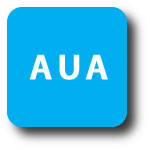ORLANDO, FL USA (UroToday.com) - The adage "see one, do one, teach one," has long been used to describe the paradigm of procedural training in medical education. Unfortunately, this paradigm may fall short in providing adequate practice prior to a trainee's initial procedure on a live patient. Many hope that improvement in quality and use of simulation technology can help rectify this situation. In this study from the University of Toronto, Lantz and colleagues posit that the "value of surgical simulators is only as good as the curriculum in which they are utilized." Thus, they developed and evaluated a simulation-based curriculum around a Cook ureteroscopy model and examined the impact of the course and validity of the model. Their program was designed for junior level residents (PGY 1-3) and included didactics as well as hands on and practice sessions.
 To assess impact, pre-course and post-course assessments were made based on standardized tasks reviewed by 2 blinded experts using a validated assessment instrument. For the 10 residents who participated in the course, tasks were completed quicker (15.8 versus 9.4 minutes, p < 0.01) and they achieved higher performance scores (19.20 versus 25.25, p < 0.01). Eighty-percent of them rated the model as realistic and five independent endourology experts considered the device useful for training. They also demonstrated significant correlation between their different measures and surgical experience.
To assess impact, pre-course and post-course assessments were made based on standardized tasks reviewed by 2 blinded experts using a validated assessment instrument. For the 10 residents who participated in the course, tasks were completed quicker (15.8 versus 9.4 minutes, p < 0.01) and they achieved higher performance scores (19.20 versus 25.25, p < 0.01). Eighty-percent of them rated the model as realistic and five independent endourology experts considered the device useful for training. They also demonstrated significant correlation between their different measures and surgical experience.
The primary conclusion of their study was that their curriculum had a significant impact on trainee performance of standardized tasks, and that the Cook ureteroscopy model demonstrated face, content, and construct validity. This study clearly makes an effort to demonstrate the importance of evaluating both simulators as well as the context of their use. It will be interesting to see whether the course has an impact on resident performance in the long-term, though this may be difficult to study without multiple cohorts in the same institution. It also begs the question: how often are simulators developed with a detailed curriculum in mind, and what is the role of course-developers in the development of simulation technology?
Presented by Andrea Lantz at the American Urological Association (AUA) Annual Meeting - May 16 - 21, 2014 - Orlando, Florida USA
University of Toronto, Toronto, Ontario Canada
Written by Martin Hofmann, MD, University of California (Irvine), and medical writer for UroToday.com


